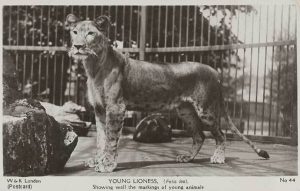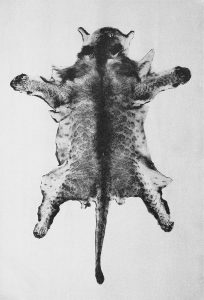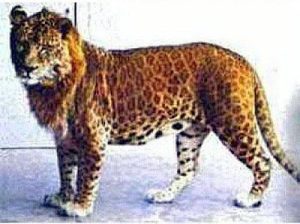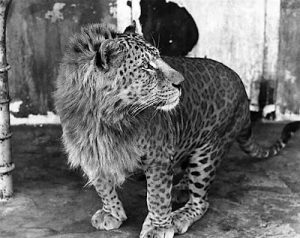Podcast: Play in new window | Download (Duration: 9:56 — 11.1MB)
Thanks to Pranav for suggesting this mystery big cat this week, the marozi!
Further reading:
From Black Lions to Living Sabre-Tooths: My Top Ten Mystery Cats
A young lioness who still has some of her cub spots:

Subadult lions who still have a lot of cub spots:

The skin of an animal supposedly killed in 1931 and said to be a marozi:

Two photos of a “leopon,” a lion-leopard hybrid bred in captivity in a Japanese zoo:


Show transcript:
Welcome to Strange Animals Podcast. I’m your host, Kate Shaw.
This week we’re going to learn about a mystery animal suggested by Pranav. It’s the marozi, a big cat from the mountains of Kenya.
Kenya is in east Africa, and humans have lived in what is now Kenya since humans existed. Because of this, usually when we talk about Kenya or east Africa, we’re talking about hominins, but today we’re talking about big cats.
Kenya is home to a lot of animals you think of when someone mentions the animals of Africa, like elephants and giraffes, and it’s also home to three big cats: lions, leopards, and cheetahs. The lion is generally a tawny brown color although different individuals and populations can be various shades of brown or gray. A lion cub is born with dark spots, and as it grows the spots fade. Sometimes a young adult lion will still have some spots, especially on its legs and belly, but in general an adult lion has no spots at all. In comparison, both the leopard and the cheetah are famous for their spots.
The lion prefers to live in savannas and open woodlands. These days it’s only found in a few parts of India, along with various places in sub-Saharan Africa. This just means south of the Sahara desert. In the past, though, the lion had a much larger range. It lived throughout most of Africa, the Middle East, southern Asia, and even southern Europe. Overhunting drove it to extinction in many parts of its historic range, which is called extirpation. I’ve used the term before but it specifically means that an animal has been driven to extinction in one area where it once lived, but it isn’t extinct in other areas. Some subspecies of lion have gone extinct, and the lions who remain are vulnerable to habitat loss, poaching, and many other factors. Just because lions are common in zoos doesn’t mean lions in the wild are doing fine.
The same is true of the cheetah, which has an even smaller range than the lion these days but which was once common throughout Africa and the Middle East along with a lot of southern Asia and Europe. We talked about the cheetah in episode 145. It’s actually not closely related to the lion or the leopard, and in fact genetic testing reveals that it’s most closely related to the puma of North America.
The leopard, on the other hand, is a very close relation to the lion. Both belong to the same genus, Panthera, which also includes tigers, jaguars, and snow leopards, but the lion and leopard are the closest cousins. While it’s also vulnerable to habitat loss, poaching, and other factors, it’s more widespread than the lion and cheetah. It lives throughout much of sub-Saharan Africa, Asia–especially India–and even parts of eastern Russia, and in the past it was even more widespread. It prefers forests where its spots help it blend in with dappled sun and shade.
So, the lion, the leopard, and the cheetah all live in Kenya, but there’s another big cat that’s supposed to live there too. It’s called the marozi, also sometimes called the spotted lion.
Stories of lions that have spots like a leopard go back for centuries among the local people. The spotted lion is supposed to be small and the male either has no mane or only a small one. It’s supposed to live in the mountains and is solitary instead of living in family groups like ordinary lions. In fact, “marozi” supposedly means “solitary lion” in the local language. Instead of living in open grasslands, it lives in thick forest where a spotted coat and smaller body size would be useful, allowing it to maneuver through the trees more easily while not being seen.
It wasn’t until the colonial era in the late 19th and early 20th centuries that Europeans became aware of the marozi. The first known sighting of a spotted lion by a European occurred in 1903, when a British soldier reported seeing more than one in the mountains of Kenya. He said the lions were darker in color than an ordinary lion, with leopard-like rosette markings. In 1924, a game warden reported killing a spotted lioness and her cubs, with the lioness having just as many spots as the babies.
In 1931 a farmer shot two small spotted lions in the mountains. He said they were fully grown despite their small size, but they had even more spots than lion cubs do. One was a male and he had a sparse, short mane. The farmer kept the male’s skin, which eventually made its way to the Natural History Museum in London, possibly with the lion’s skull too, although it’s not clear if the skull actually belongs to the same animal. As far as I could find out, no one has tried to test the skin and skull genetically.
Other people, including hunters and game wardens, reported seeing spotted lions in high elevations where ordinary lions didn’t live, with stories continuing through at least the 1960s. Similar stories of a spotted lion have been collected from mountains in other parts of east and central Africa, including Ethiopia, Rwanda, Uganda, and Cameroon, where it has different local names. But so far we don’t have any photographs or a specimen.
There are a few hypotheses about what the marozi might be. One suggestion is that it’s actually a hybrid of a leopard and a lion. Because leopards and lions are so closely related, they can interbreed and produce offspring, although as far as we know this has only happened in captivity. In the wild, lions are actually aggressive towards leopards. A lion will steal a leopard’s food and will sometimes even kill leopards, and as a result leopards try to avoid lions. Since leopards prefer thick forest and lions prefer open forest or grasslands, they don’t cross paths all that often anyway.
In the late 1950s into the early 1960s, a zoo in Japan kept a male leopard and a female lion in the same enclosure to see if they would mate. They did, and eventually they had two litters together. The cubs were larger and heavier than leopards but not as big as lions, and while they generally looked like lions they had leopard spots. The males had small manes.
This sounds a lot like reports of the marozi, but again, in the wild lions and leopards mostly avoid each other. The only time a lion and a leopard would consider each other potential mates instead of potential trouble is when they’re put together artificially as in the Japanese zoo. Even if an occasional leopard and lion do sometimes breed in the wild, it wouldn’t happen often enough to cause all the sightings documented about the marozi. Besides, the marozi is only reported from the mountains, where lions don’t live.
Another hypothesis is that there’s a population of ordinary lions that have moved into the mountains to escape factors like habitat loss, poaching, and a decline in prey animals, and that people occasionally see a young adult lion that hasn’t completely lost its cub spots. This isn’t too likely either since stories of the marozi go back to long before these modern pressures on lion populations.
There might very well be an unknown, very rare species or subspecies of lion that has always lived in the mountains in parts of east and central Africa, and that it does actually have spots as an adult. If this is the case, hopefully it’s safe in its mountain habitat from the pressures faced by ordinary lions. Let’s hope also that it comes to the attention of scientists soon so it can be studied and protected.
You can find Strange Animals Podcast at strangeanimalspodcast.blubrry.net. That’s blueberry without any E’s. If you have questions, comments, or suggestions for future episodes, email us at strangeanimalspodcast@gmail.com. We also have a Patreon at patreon.com/strangeanimalspodcast if you’d like to support us for as little as one dollar a month and get monthly bonus episodes.
Thanks for listening!